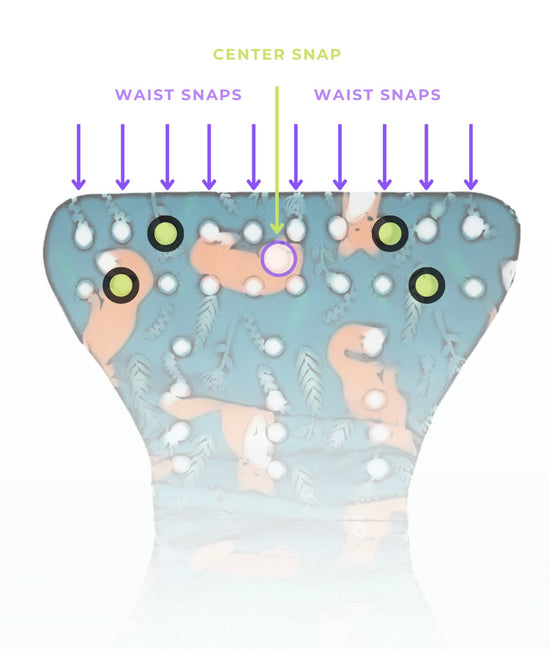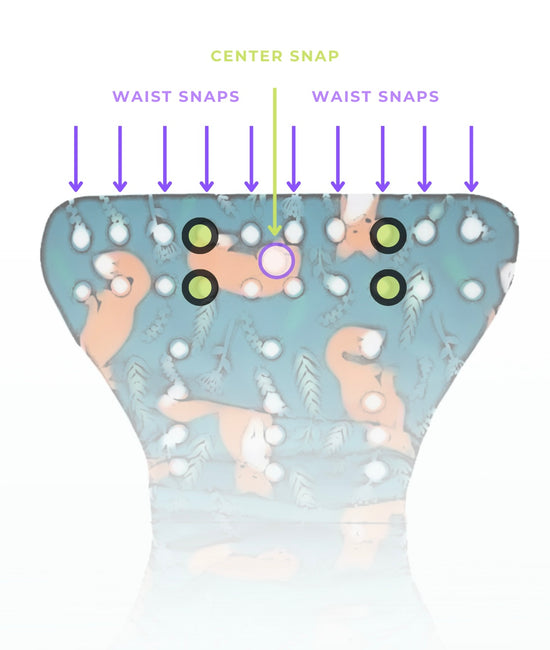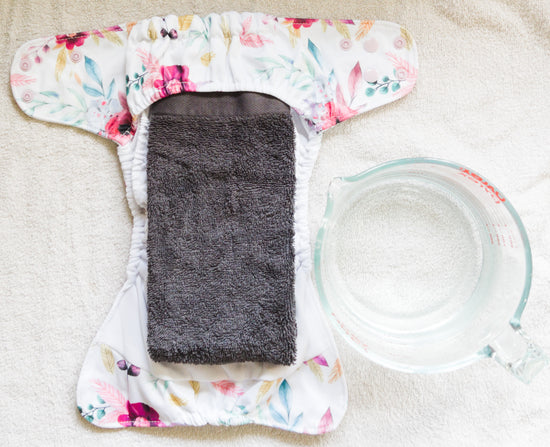Cloth Nappy Troubleshooting
Starting your cloth nappy journey can be a bit of a learning curve. Whether you are a mumma who has always had trouble with leaks or a mumma who never had any issues, but suddenly experiencing leaks out of nowhere - read on for our cloth nappy troubleshooting which will can help identify any fit, absorbency or leak issues & how to solve them.
Quick Tips
Snaps do not have to be "even"
Cloth nappies with plenty of fitting snaps give you the felixibility to snap into whichever row and width feels best.
Your nappies wing snaps can be angled/staggered and snapped into wasit snaps that are not necessarily "in line" with each other.
Another solution to getting a good fit can sometimes warrant an uneven snap set up where one side is a little bigger than the other. See pictures below.
This can be especially helpful if your bubs has a unique body shape or they are going through a growth spurt, where their body shape changes temporarily.
Use nappy liners
Nappy liners can protect your nappy and inserts from any residue build up when using barrier creams.
Nappy liners also make those poopy nappy changes much easier.
Choose from either a microfleece or AWJ nappy liner
Do you have a quick nappy insert absorbency guide?
To view or download - click on Nappy Insert Absorbency Guide
Inserts getting stiff?
While stiff inserts are not so much of an issue with Mumma Bear inserts, it is a question we get asked from a lot of mums that use multiple brands.
Once your insert is dry, tightly roll your insert, give it a good scrunch once rolled up, and release. Your inserts should be more pliable now.
-

"Staggered snaps" example
-

"Uneven snaps" example
Why is my cloth nappy leaking?
Inadequate absorption
There are usually two culprits to inadequate absorption.
- Your baby is flooding their inserts: This is when your babies speed of output is not handled as quickly by the insert. You will know if your baby is flooding their cloth nappy by checking the insert. If the insert is not saturated & has dry areas - You are experiencing flooding. You can boost your inserts with a faster absorbing insert. This allows enough time for your insert to fully absorb your babies output at a speed it can handle.
- Your baby is saturating their inserts: If your inserts are fully saturated, you will need more absorption by considering adding inserts or using a different combination to keep up with your babies capacity requirements.
The fit needs adjusting
A bad fit can affect how your cloth nappy works & can be prone to leaks if not fitted properly.
Key things to rememeber;
- No more than 2 fingerwidth gap at the belly
- No leg gaps around the thighs
- Tuck (and taco) the cloth nappy into babies undie line/groin
- Tuck excess farbic at the rise snaps upwards into the nappy/behind the tummy panel
Our premium nappies are very forgiving with fit and come with a tonne of anti-leak features to give your baby a dry and comfortable experience.
Find our fit guide here
Compression leaks
Compression leaks are usually from either the insert type you are using, or happening from tight clothing that presses down on the nappy (or a combo of both!)
Microfibre inserts can be prone to compression leaks (think of them like a sponge) as they are quick absorbers. Either pair these alongside a high capacity insert, like bamboo, or consider using an insert like bamboo cotton instead.
If your leaks are coming from tight clothing - it can be worth looking into onesie extenders.
Build up of residue
Barrier creams, fabric softeners and some detergents (causing washing powder rash) can create an excess build up on your nappy lining and inserts.
You will know if you have a residue build up if your'e finding your cloth nappy or inserts are not absorbing much and instead creating leaks.
Residue build up is excess product blocking the little holes, vital for absorbption and allowing liquids to pass through, in your nappy and inserts.
A good washing cycle will help avoid building up any residue.
If you do find you have a build up - a few 40-60 degree washes will help remove the residue.
You can also consider doing a sanitising cycle.
To further prolong the life of your nappies and inserts, use a microfleece or AWJ nappy liner which will help protect your cloth nappy lining from residue buildup.
Compromised nappy shell
Compromised nappies are quite rare unless the nappy shell is faulty or old.
Unfortunately there are no long lasting solutions to fix a compromised nappy shell but they can be used as a swim nappy.
To see if your nappy shell waterproofing is compromised it's best to visually inspect the PUL or do a tea towel test.
For visual inspection, turn the nappy inside out to expose the underside of the PUL. If the PUL has been compromised, you will be able to see the outer fabric (printed side) exposed through the cracks, especially when you stretch the fabric slightly. You may even be able to observe larger tears or holes from being brittle or cracked.
Please see below for how to do the Cloth Nappy Tea Towel Test. Please read the instructions carefully as the test will fail if not followed correctly.
It is important to note that all cloth nappies have weak points in the PUL. These will be found along the stitching due to the holes created by the sewing process. Adequate absorpotion will help mitigate liquids escaping from these holes.
Too much bulk
If you’re using too many inserts or using a combination of bulky insert types - this can compromise getting a good leg seal.
Too much bulk can create a gap between the nappy and your babies legs, which can allow liquids to escape.
Microfibre inserts tend to be the most bulky.
Try using less bulky (but high capacity) inserts to pair with your booster, such as bamboo cotton paired with bamboo.
Cloth Nappy Tea Towel Test
You will need:
- 2x tea towels
- The nappy that you want to test (this must be clean and dry)
- Water / water jug
Instructions
- Lay flat one of your tea towels on a clean & dry surface - Place your nappy on top of the towel, with the inside of the nappy facing up.
- Fold your second tea towel into a rectangle that comfortably fits inside the nappy, ensuring none of the folded tea towel is touching the edges.
- Remove folded tea towel and wet until it is very damp to the touch but not dripping. Place the now wet, folded tea towel, on top of the open nappy - ensuring enough clearance from the edges of the nappy. The test will not be reliable is the tea towel has leaked around the edge of the nappy so pay close attention to placing the tea towel well inside the nappy.
- Leave for about 30 minutes to an hour.
- Once the time is up - if the tea towel under the nappy is at all damp, it means that your waterproofing has been compromised. Take note of the location where the dampness is as this usually corresponds to where the hole or damage is. If the tea towel is still completely dry, then your waterproofing is intact.
-

Cloth Nappy Tea Towel Test



